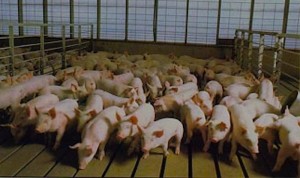Economist: Nation’s pork industry faces tight margin year
By Debra Levey Larson — January 21, 2016

According to Purdue University Extension economist Chris Hurt, pork production is expected to rise by about 1 percent.
Pork producers are expected to experience another year of tight margins in 2016, similar to the year just completed.
According to Purdue University Extension economist Chris Hurt, pork production is expected to rise by about 1 percent, but beef production will rise by 4 percent and poultry by about 3 percent.
There will be plenty of meat and poultry for consumers and retail prices will likely fall, encouraging them to buy more.
Hurt provided the following analysis.
First, a review of last year. In 2015, the number of pigs per litter set new records in each quarter. Annual pigs per litter set a new record high in 2015 at 10.38 pigs.
Hog prices were depressed in 2015 due to a 7 percent production increase on a combination of 8 percent higher numbers and 1 percent lower weights. Pork trade was also a negative for hog prices in 2015 as the strong U.S. dollar encouraged more pork imports, especially from Canada. Data currently available on trade suggest that higher pork imports increased pork supplies by an additional 2 percent. With 7 percent higher production and 2 percent greater imports, total available supplies in the U.S. were up nearly 9 percent. The large supply surge became a concern in the last two months as prices fell to six-year lows that were well below costs of production.
What about 2016?
The Dec. 1 USDA Hogs and Pigs market hog inventory estimate suggests some let up in the large market supplies in late 2015. The USDA inventory estimate suggests that market supplies were up 5 percent in December, but should begin to taper off in the new year.
First-quarter supplies suggested by the USDA inventory would be up about 1 percent, but weights are expected to be down, so total first quarter pork production may be unchanged to up 1 percent if USDA inventory numbers are accurate. Using the USDA inventory numbers, second-quarter pork production would be down 1 percent.
What about summer and fall pork production?
Pork producers indicated to USDA that they would reduce farrowings this winter by 2 percent with farrowings unchanged in the summer. If so, pork production would be down 1 percent in the second quarter, unchanged in the third quarter, and up 1 to 2 percent in the fourth quarter. For 2016, production would be unchanged to 1 percent higher than last year.
How will trade affect hog prices in 2016?
USDA’s current outlook is for pork exports to increase by 4 percent with steady imports. If those projections are correct, trade would help increase prices a bit for 2016. However, the strength of the U.S. dollar will likely be a continued shadow over improved pork trade.
Further headwinds for 2016 hog prices will come in the form of growing supplies of competitive meats led by a 4 percent expansion of beef supplies. Poultry production will rise by about 3 percent and with about 1 percent more pork, total meat supplies will be nearly 3 percent higher. The beneficiaries will be consumers who will see lower retail pork and beef prices in 2016.
For the year, live-weight hog prices are expected to average in the higher $40s after averaging near $50 in 2015. Prices are expected to average in the mid-$40s in the first quarter before moving upward to average in the low-to-mid $50s in the second and third quarters. Prices are expected to drop to the mid $40s for the final quarter.
Hurt said his cost-of-production estimate for farrow-to-finish production in 2015 was $51 per live hundredweight. A modest reduction to $50 is expected for 2016. The slight reduction is due primarily to lower soybean meal prices.
Margins are expected to be negative for the year with an average loss of about $4 per head.
Debra Levey Larson, writes for the University of Illinois Extension Office and can be reached at (217) 244-2880 or at dlarson@illinois.edu.
— Economist: Nation’s pork industry faces tight margin year —



